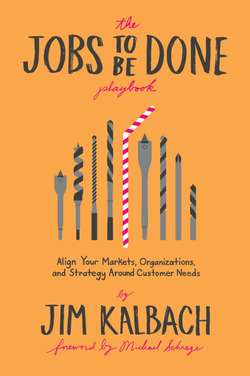Читать книгу The Jobs To Be Done Playbook - Jim Kalbach - Страница 14
На сайте Литреса книга снята с продажи.
Defining JTBD
ОглавлениеEvery day, you have dozens of objectives that you strive to accomplish. You drink coffee to get energy in the morning. Then you might drive to a park-and-ride to take the train while you commute to work. At the office, you collaborate with colleagues to complete a project or deliver a pitch to a new client. Back home, you might eat a piece of chocolate to reward yourself after work and then prepare a meal to enjoy with your family.
These are all jobs to be done (JTBD).
The JTBD approach offers a unique lens for viewing the people you serve. Instead of looking at the demographic and psychographic factors of consumption, JTBD focuses on what people seek to achieve in a given circumstance. People don’t “hire” products and services because of the demographic they belong to (e.g., 25–31-year-olds, have a college degree, earn a certain salary); instead, they employ solutions to get a job done.
JTBD is not about your product, service, or brand. Instead of focusing on your own solution, you must first understand what people want and why that’s important to them. Accordingly, JTBD deliberately avoids mention of particular solutions in order to first comprehend the process that people go through to solve a problem. Only then can a company align its offerings to meet people’s goals and needs.
Early origins of JTBD thinking point to Theodore Levitt. The famous business professor was known for telling students, “People don’t want a quarter-inch drill, they want a quarter-inch hole.”1 This quote captures the essence of JTBD: focus on the outcome, not the technology. The drill is a means to an end, not the result.
Peter Drucker, a contemporary of Levitt and father of modern management, first used the phrase “jobs to be done” in relation to customer needs. In his 1985 book Innovation and Entrepreneurship, Drucker wrote:2
Some innovations based on process need exploit incongruities, others demographics. Indeed, process need, unlike the other sources of innovation, does not start out with an event in the environment, whether internal or external. It starts out with the job to be done.
But neither Drucker nor Levitt used the label “job to be done” in any consequential way to refer to their ideas or approaches to solving business problems. It wasn’t until Clayton Christensen popularized the term in The Innovator’s Solution, the follow-up to his landmark work, The Innovator’s Dilemma, that the concept became widespread.
Although modern references of JTBD point back to Christensen, definitions of JTBD vary in practice. Table 1.1 at the end of this chapter presents how a “job” is defined by thought leaders in the field. Comparing them side-by-side shows variation in approach, but also reveals commonalities.
Overall, JTBD is about understanding the goals that people want to accomplish, and achieving those goals amounts to progress in their lives. Jobs are also the motivators and drivers of behavior: they predict why people behave the way they do. This moves beyond mere correlation and strives to find causality.
My definition of a job is simple and broad:
The process of reaching objectives under given circumstances
My use of the word “objectives” is deliberate. It better reflects the functional nature of JTBD. I don’t use the word “goals” in my definition in order to avoid associations with broader aspirations, e.g., “life goals.” This isn’t to say that aspirations and emotions aren’t important in JTBD. Instead, my interpretation of JTBD sequences the steps for creating offerings that people desire: first, meet the functional objectives and then layer the aspirational and emotional aspects onto the solution.
My definition of JTBD also includes an explicit mention of a process, highlighting the dynamic nature of getting a job done. In other words, an “objective” isn’t just about an end point, rather an objective itself is a process that unfolds over time. The goal across the above definitions is the same: leverage a deeper understanding of how people make choices to create products they truly demand.
